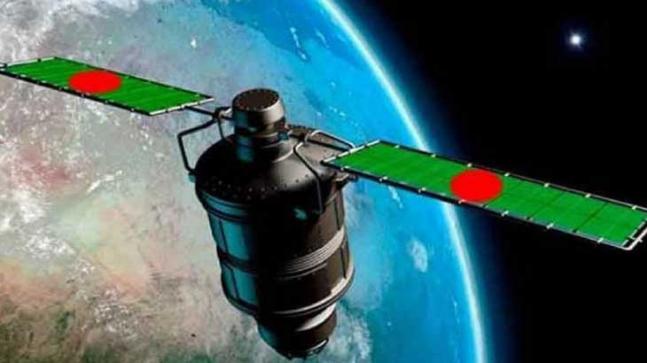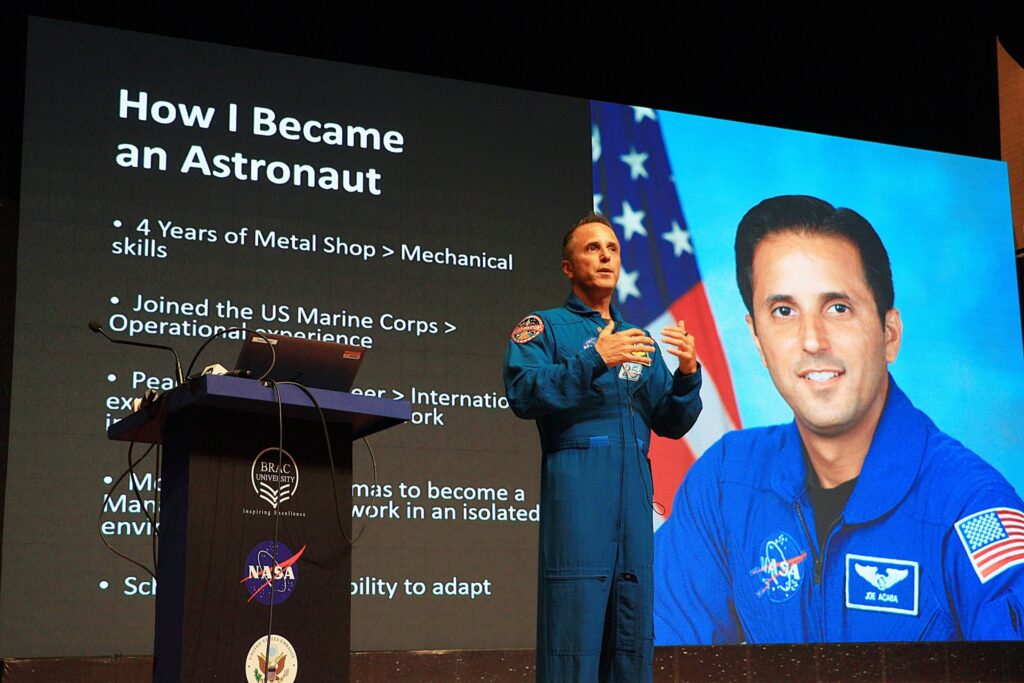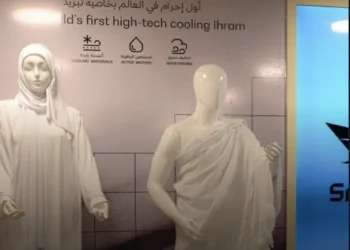“Once we had dreams of sending manpower abroad. Today, we dare to dream of sending satellites—and someday, astronauts—into space.”
This is not fiction. This is not a wish. This is the story of how Bangladesh officially became a part of NASA’s future in space exploration. When we think of NASA, our thoughts drift to rocket launches, the landing on the Moon, or maybe even the audacious plan to colonize Mars. In contrast, when we think of Bangladesh, we visualize the colorful streets of Dhaka, the powerful Padma River, or the frantic garments industry. But what if these two seemingly different worlds suddenly intersected? That’s exactly what happened when NASA and Bangladesh signed a groundbreaking cooperation contract — a move that promises to unlock a new era of science, technology, and limitless possibilities.
Bangladesh Signs the Artemis Accords
On April 8, 2025, Bangladesh took a significant step in its space exploration journey by signing the Artemis Accords with NASA, becoming the 54th nation to join this U.S.-led initiative aimed at promoting peaceful and cooperative space exploration. The signing ceremony took place in Dhaka during the Bangladesh Investment Summit and represents the country’s effort to develop space research capabilities.

The Artemis Accords are like a space constitution. Launched by NASA in 2020, they lay out how countries will explore the Moon and beyond peacefully, transparently, and responsibly.
By signing, countries agree to:
- Cooperate on space missions
- Share scientific data
- Avoid harmful conflicts in space
- Protect historic lunar landing sites (like Apollo 11!)
- Build sustainable presence on the Moon and maybe even Mars
Countries like the USA, UK, Japan, Brazil, and now—Bangladesh—are part of this new space alliance.
Why Would NASA Work With Bangladesh?
The signing program began with a virtual message from Janet Petro, acting administrator of NASA, where she mentioned that the visit of Joseph M. Acaba, chief astronaut at NASA, last December began the process and the introduction of the Artemis Accords in Bangladesh.
“The young minds of Bangladesh have shown the world their passion for space exploration. In four of the last six years, Bangladeshi innovators have been global champions in NASA’s space apps challenge. Their creativity and drive exemplify the future of space exploration and I have no doubt we will continue to see extraordinary scientists, engineers and even future astronauts emerge from Bangladesh,” Janet said.
The sky? That’s no longer our limit. It’s just the beginning
Space exploration may sound like a luxury for rich countries — but for Bangladesh, it has the potential to become a lifesaving necessity.
Imagin a locally designed micro-satellite built with support from NASA to monitor floods, river erosion, salinity intrusion and crop health space-based data nationally.With this technology, we can:
- Provide real-time flood alerts to vulnerable coastal communities
- Help farmers make data-driven decisions to boost crop yields and reduce losses
- Track changes in water levels, pollution, and soil health in remote regions
- Monitor climate change impacts and adapt faster with science-driven responses
In a country where every inch of land, every drop of water, and every life matters—space is no longer distant. It’s personal. It’s essential.
Detecting Arsenic in Groundwater from Space
Bangladesh’s groundwater crisis is invisible to the naked eye—but not to hyperspectral imaging. A satellite equipped with sensitive sensors could map areas with high arsenic concentrations, warning communities before they fall ill, and guiding safer well placements.
Predicting Cyclones with Greater Accuracy
NASA-grade satellite data could enhance our early warning systems by hours or even days. That means more time to evacuate, secure crops, and save lives—especially in low-lying regions like Barisal or Khulna.

Tracking Illegal Logging in the Sundarbans
By analyzing satellite imaging, we could track real-time deforestation. The authorities could be notified as soon as tree cover drops, allowing a rapid response to the threat to our precious mangroves — and the communities they protect from storms.
Smart Irrigation in Drought-Prone Regions
In areas such as Rajshahi or Dinajpur, space data can be utilized to determine when and where to water fields,preventing overuse and reducing crop failure during dry seasons
Public Health Monitoring from Above
What if we could track urban heat islands in Dhaka and identify areas at high risk for heatstroke or mosquito-borne diseases like dengue? With the right satellite imagery and AI, we can target health responses more effectively.
Land and River Mapping for Smart Planning
From encroaching rivers to shifting coastlines, satellite data can help planners and engineers design better infrastructure—roads, bridges, embankments—that last longer and protect more people.
Electrifying Remote Communities
By identifying solar-rich zones using satellite data, we can deploy solar panels in off-grid villages more efficiently, lighting up homes and schools without waiting for decades of infrastructure development.
Disaster Detection in Hill Tracts
Early detection of fires in the Chattogram Hill Tracts or Modhupur forest could save biodiversity and prevent large-scale environmental disasters—space-based infrared sensors can spot heat anomalies quickly, even in remote terrain.
Read More: Grameenphone: A Vision Beyond Connectivity
Youth, Education & Future-Oriented
Now let’s talk real talk. What does this mean for us—the students? The future of Bangladesh?
Excitement in STEM Education
The recent signing of the Artemis Accords by Bangladesh has ignited a wave of excitement across educational institutions. Universities are poised to enhance their curriculum, integrating advanced space technology and aerospace studies. Anticipated developments include:
- Workshops on satellite design
- Seminars featuring NASA scientists
- Coding competitions utilizing real-time space mission data
These initiatives aim to inspire students to envision themselves as future contributors to space exploration, perhaps even participating in Mars habitat projects.
Access to Internships, Collaborations, and NASA Hackathons
Bangladeshi students now have the opportunity to engage directly with NASA through various programs:
- NASA International Internships: Through agreements with institutions like the International Space University, students can work on NASA projects, gaining invaluable experience .
- NASA Pathways Program: A work-study initiative offering paid internships that serve as a pipeline to full-time employment at NASA .
- NASA Space Apps Challenge: A global hackathon where participants solve real-world problems using NASA’s open data .
These programs provide platforms for Bangladeshi students to contribute to international space missions and research from their own campuses.
Growth of Space Clubs and Startups
The momentum is building in university-level clubs focused on robotics, AI, and satellite technology. With the Artemis opportunity, these clubs are evolving into research cells and startups, developing earth-observation tools and educational space tech for younger students. The burgeoning space economy is being fueled by these young innovators.

BRAC University has been at the forefront of fostering connections with NASA:
- On the 15th of December 2024, Joseph M. Acaba, the Chief Astronaut of NASA, visited BRAC University and talked about his distinct 306 days experience in space to more than 500 participants.
- On December 12, 2024, NASA scientist Mr. Mizanul Hoq Chowdhury inspired students in discussions on space science, robotics, and engineering, as well as research cooperative education that may be pursued with LHU.
All of these are ways in which BRAC University is asserting itself as a central character in the space exploration narrative of Bangladesh.
A New Cultural Narrative
Beyond economy and education, there’s something even more powerful brewing—a shift in the national mindset.
- We’ll stop thinking of space as “their thing” and start calling it “our future.”
- Parents will encourage kids to pursue space science, not just medicine or engineering.
- Kids will grow up dreaming not just of going abroad—but of going beyond.
That’s cultural transformation. That’s how Bangladesh evolves into a knowledge-based nation.
Read More: BUBT Career Fair 2025: Bridging Dreams with Opportunities
The Challenges We’ll Face
Of course, we must be realistic. This path is exciting but not easy. There are challenges:
- Infrastructure: Our labs and observatories need serious upgrades.
- Faculty Shortages: Not enough experts to teach space science yet.
- Brain Drain: If we don’t offer opportunities locally, our best minds will leave.
- Skepticism: Some will ask, “Why spend on space when we need hospitals?”
But the answer is: space science helps with both. From satellite-aided telemedicine to disaster monitoring, it directly improves life on Earth.
The Future We Can Build
Here’s what Bangladesh might look like 10 years from now—if we stay on this path:
- Bangladeshi-built satellites orbiting to study rivers and weather
- A “Bangladesh Lunar Research Hub” partnering with NASA for moon base projects
- Thousands of students publishing in space journals, working in global space agencies
- A tech economy thriving with startups born from NASA-collaboration
- And maybe… our first astronaut suiting up for a lunar mission.
It sounds like science fiction.Now they’re real.
Final Thoughts: Why This Deal Matters
By signing the Artemis Accords, Bangladesh has said, loudly and clearly:
“We believe in peace, science, and the human dream of exploring the unknown. We may be a small nation on the map, but we have a giant vision.”
This deal is not just between two governments. It’s between generations.Between the past that built bridges across rivers and the future that will build bridges across space. To every student who has ever looked up at the stars and wondered “What’s out there?”—this is your moment. To every teacher who believes in inspiring curiosity—this is your time. To every policymaker who dreams of a smart, sovereign, tech-driven Bangladesh—this is your mission.
References


















